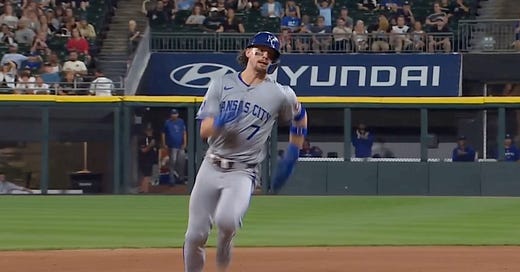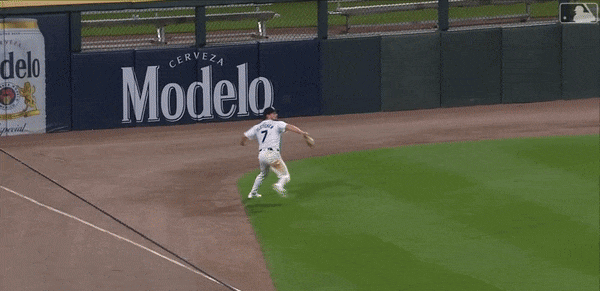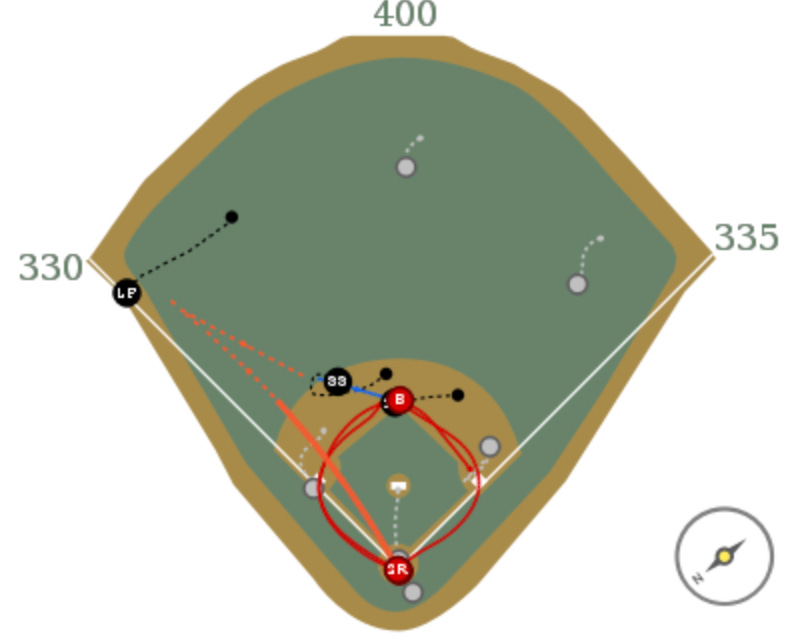A frenzied Tuesday
JJ Picollo is making trades and the Royals are finding another way to come back and steal a victory from the White Sox.
The Royals’ scorecard on Tuesday will read like this:
Two trades at the deadline.
One more late-inning rally and victory.
With the Royals hanging tough in the AL Wild Card race, they took advantage of their opponents on the field while General Manager JJ Picollo hammered out a couple of deals just ahead of the deadline. By the time the frenzy was over, the Royals found themselves winners on both fronts.
Once again, the Royals left it late against these Hapless White Sox, staging yet another eighth-inning rally to overcome a deficit and seize the 4-3 victory. The hero was the same, though. Yes, that man again. Bobby Witt Jr. After Monday’s grand slam (99 MPH off the bat, traveling 384 feet) Witt went the alternate route—a little Texas Leaguer that looked for a moment as if it would be caught in shallow center field. The flare was just 72 MPH off the bat and flew just 224 feet, but it was enough to bring Maikel Garcia home with the tying run.
Do you think Pedro Grifol should’ve walked Witt in that situation? In that moment the Royals were trailing by a run, had runners on the corners and one out. I mean, in that situation you’ll take Witt up at the plate all day long. If you’re the White Sox do you let a potential MVP beat you two nights in a row? Sure, the Sox were sliding to their 16th consecutive defeat, but that doesn’t mean all strategy goes out the window.
Here’s the danger with walking Witt. He’s just as much of a game-changer on the bases as he is at the plate.
With runners on first and second, that brought up Vinnie Pasquantino. He laced a ball down the left field line and the runners were off. Dairon Blanco (pinch running for Freddy Fermin who walked on four pitches) would score easily with the go-ahead run. Witt, didn’t break stride as he was going for third.
This is the moment when everything changes. It’s the difference between one run or two. Chicago left fielder Dominic Fletcher throws the ball to Nicky Lopez who was the cutoff man at second. Lopez was positioned almost exactly between second and third. With Pasquantino trying to leg a double, Lopez spun and fired to second, ignoring Witt (and third base coach Vance Wilson). While the ball was en route to Lopez, in that split second Wilson reads the situation that the Sox are going for a play at second and waves Witt home. The Royals plate their fourth run of the game.
Witt, as you would expect, is going hard into third. The man is relentless. It doesn’t work unless he’s already flipped the afterburners. Although for Witt I think “afterburner” is just his standard mode of getting around the bases.
I think it’s clear that if Lopez doesn’t go to second, there’s a chance for a play at the plate. He receives the ball when Witt touches third. A throw home should beat him. Of course, the location of the throw would matter, but the Sox didn’t even go that route.
Not to fully absolve Lopez, but he’s literally in no-man’s land at this moment. He’s expecting Witt to go first to third, which is clearly a mistake as everyone knows Witt is always looking for the extra 90 feet. Yet it’s early in the play that his teammates if they were locked in on the action, which given this White Sox team is never certain, would’ve called out to go home on the play. But Lopez has the ball and is making the throw to second before Witt hits third. He at least recorded the out at second.
Yes. It was highly reminiscent of Eric Hosmer singling home Lorenzo Cain from first base in Game Six of the 2015 ALCS. Only this ball was hit to left and there were two runners on base. It turns out, that play is practically force-fed Royals minor leaguers. With reason, obviously. From Anne Rogers, here’s Pasquantino’s take of the play:
"There are a few things that go on in that play. It's kind of reminiscent for Royals fans to the (Jose) Bautista play in 2015 (Game 6 of the 2015 ALCS). It's something that, coming up in the Minor Leagues, we studied that play, annoyingly - J.J., I'm talking to you. Baseball 101. We studied that play every morning. But it paid off tonight. The guy who hits the ball: Go. Push it to second. Obviously, Bobby's running, he hustles all the time. And he's the fastest player in the league, so it helps when that's the case. And then Vance is the MVP of that play. Sending him there, reading where their left fielder threw the ball in to their shortstop. Just a really, really good baseball play. I think we're all pretty pumped about it, when things you study like that, pays off in a game where we really needed it.
I've never done it. First one. But you kind of know, especially when it's first and second, that play's live all the time. You want the outfielder to throw it toward second base. It puts the second baseman or shortstop in a tough spot because you don't know if he's going home, so you know that I'm going to second and you're going to throw me out. It's one of those things. A very niche baseball play that happens once every few years or so. It's really situational."
This play is a microcosm of the divide between the Royals (a good team) and the White Sox (a very bad team). The Royals are prepared for this moment. It’s a situation they’ve gone over again and again. As Pasquantino says, it’s rare when that moment arrives, but the good team is ready. The bad team is just kind of lost. Making a play with no forethought as to how things can—or will—unfold. They recorded an out, so it wasn’t a total disaster, but the cost was a run. In a game where the margin was a single tally.
The White Sox have lost 16 in a row. The Royals moved to a virtual tie with the Twins for second place in the AL Central and for the second overall Wild Card.
Before the game the trade deadline was the news of the day. The Royals, as expected, pulled the trigger on a couple of deals as the clock was winding down. First up, they acquired reliever Lucas Erceg from the Oakland A’s.
When news broke that Erceg was coming to Kansas City, I have to admit that I was somewhat taken aback. The Royals and JJ Picollo were adamant they were not going to sacrifice the future (meaning top prospects they felt could make a major league impact) for a short-term gain. Erceg made his major league debut just last year with Oakland, meaning he will have less than two years of service time once this season wraps. He won’t be a free agent until 2030. That kind of control comes with a cost.
In the Royals’ case, that cost was pitchers Mason Barnett, Will Klein and outfielder Jared Dickey.
The headliner of the deal is Barnett. He was the Royals’ 11th-best prospect entering the season according to Baseball America and was again number 11 when BA released their midseason rankings. Barnett was the team’s third round draft choice back in 2022 out of Auburn. Barnett progressed to Double-A last summer where he had some success, pitching to a 3.58 ERA and 31 percent strikeout rate in just over 30 innings. He was the organization’s Minor League Pitcher of the Year last year. This season, the right-hander has posted a 4.91 ERA and 27 percent strikeout rate in around 90 innings.
He’s a projectable back of the rotation starter or long reliever. It seems to me that to acquire the services of a pitcher like Erceg, that’s a solid guy to surrender.
Erceg was drafted in the second round of the 2016 draft by the Milwaukee Brewers as a third baseman. He reached Triple-A, but never really got his bat going. He scrapped the infield and became a pitcher in 2021. The A’s purchased him from the Brewers in May of last year and he’s been a mainstay of Oakland’s bullpen ever since. In 91.2 career major league innings, Erceg has punched out 109 batters while walking 49. The calling card is his live arm. We’ve been saying this all summer: The Royals need hard-throwing relievers who miss bats. Well, with a fastball that averages 98.5 MPH, the Royals got their man.
Yeah, the walk total isn’t ideal, but Erceg has done a fantastic job cutting that rate from 13 percent last year to his current eight percent.
Erceg brings a four-pitch arsenal with him throwing that hard four-seam along with a sinker (that also averages 98.5 MPH). He compliments the hard stuff with an unhittable slider—opponents are hitting just .067 against that pitch—and a changeup. The changeup isn’t anything to get excited about, although is does have some nice lateral movement.
If the changeup is underwhelming, his Statcast peripherals are enough to get you geeked up about this deal.
A hard-throwing right-hander who gets hitters to chase, misses bats, avoids hard contact and keeps the ball on the ground? If the Royals can drop him in the pitching lab and unlock even more spin on that slider while enhancing that change…They’ve found their closer. And they have him for the next five seasons.
This is simply a fantastic deal by Picollo and the Royals. One I didn’t think they had the prospect capital to make given the way early trades were falling leading up to the deadline.
The other trade the Royals made was for White Sox infielder Paul DeJong. DeJong has mostly played shortstop in his eight-year major league career. I think that position is spoken for on this team. He’s also dabbled a bit at second and just this year has seen some action at third. I guess if we’re going to identify a “type” when it comes to players Picollo likes to acquire, it might be middle infielders who can play multiple positions.
DeJong brings a little bit of pop from the right side. He hit 30 home runs in 2019 and has crushed 18 of them so far this year. He has hit .229/.296/.419 in his career, including .228/.275/.430 in 2024.
I imagine DeJong will get some reps at third while perhaps working in as a platoon option at second with left-handed hitting Michael Massey. Really my first thought about this deal was that DeJong must feel like a hostage who has been released by his captors. It has to feel good to get out of that White Sox clubhouse.









More than anything, I wanted an OBP bat. They didn't get that. But Erceg was a guy I was very excited about so the bullpen just got a LOT better. I've argued that the best way to improve the bullpen is to take pressure off the existing guys, who all do just fine when they aren't in a pressure situation. I wanted to do that with more runs, but maybe shifting them all down and letting Harvey and Erceg do most of the heavy lifting will work
Love the insight into Vinnie's decision to go to second and the fact that this is more than a smart player making a smart play, it's an institutionalized decision.
Now I need to see someone run through 2nd base to to prevent a double play (instead of sliding 10 feet from the base!) in order to get a run home.